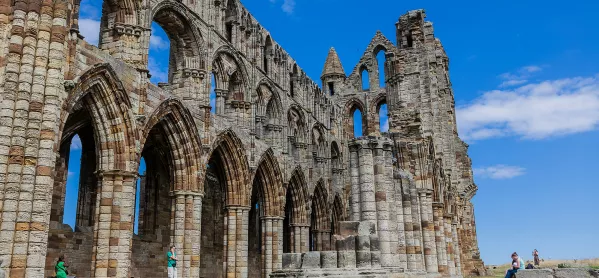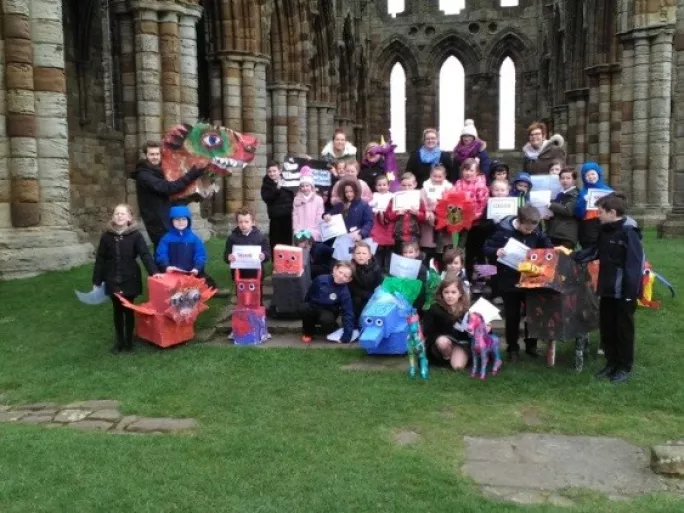How historic sites inspire learning

Working in heritage education, I’m always in awe of the creative and diverse teaching opportunities that the historic environment presents. The towering medieval keep as an expression of power and wealth, controlled and protected by the lords, ladies and knights of the period; the ruined monastery a poignant reminder of the importance of the Church in Tudor England and the impact of one man’s will on the nation’s religious houses. The stories spring from these sites as topics fully formed and ready to be explored, but there are a host of stories beneath the surface waiting to be brought to light.
One of the best parts of my role as education visits officer is being able to see the different and wonderful ways that schools engage with the historic environment. With a vast array of English Heritage sites to visit, there’s a wealth of learning opportunities to explore.
During one of my first visits to Conisbrough Castle in South Yorkshire, I witnessed a group of Year 1 students taking part in “Harry Potter Olympics”. What looked like great fun and separate to curriculum learning was skillfully turned into inspiration for literacy and creative writing. The teaching staff used the excitement of the students as a springboard for further learning, with the castle providing the perfect background.
Channelling students’ creativity
The physical remains of the site allowed for an incredibly immersive experience that helped to channel the students’ creativity and develop their literacy skills. It really emphasised that the historic environment is not “just a pile of old stones” and a place to study history, but a place to be engaging and expressive, allowing for cross-curricular educational experiences.
It’s great to see schools and teachers embrace their local historic sites and a project that really delighted me took place at Whitby Abbey in North Yorkshire. The site lends itself to history and English study, and has strong literacy connections, having served as the inspirational backdrop for such authors as Caedmon, Saint Bede the Venerable and Bram Stoker.
Students from a local school were studying myths and legends and were using the story of Abbess Hild as inspiration. One legend of Abbess Hild has her turn a plague of snakes to stone, which explained the presence of the “snake-like” Hildoceras bifrons found along the nearby coast. The students were tasked with creating sculptures of their own mythical beasts, and presenting information on its description, habitat and diet.

The school’s headteacher asked for permission to display their artworks at the abbey and to allow the students to speak to any members of the public who would be interested in seeing the project. Friends and family came to view the mythical menagerie with each student group proudly standing by their creatures and telling the public all about the wonderful sculptures. This public engagement really extended the students’ learning, providing an enriching and exciting cross-curricular experience that should live long in their memory.
The students delighted in explaining all about their creations’ habitat and diet. A wonderful mix, which showcased the imagination and humour of the student group. The project brought a fantastic creativity and excitement to the students and certainly helped with public speaking, literacy and arts and crafts.
Another aspect of the project was the “inspiration tree”. While visiting the Abbey a week before the sculpture display, each student was given time to explore and have a tactile and immersive experience. On return to the classroom, the teachers worked with the students to create short poems and haikus about their experience of the abbey. Each piece was then written on a paper leaf - some in braille - which, when hung from the empty branches, slowly covered the inspiration tree.
The project covered so many areas of educational and social development and it was great to see such a creative use of the historic environment. In the case of the inspiration tree, the students could literally watch their learning grow and take shape.
Cross-curriculum learning
Many locations are great examples of continuity and change throughout history and can also present the most diverse teaching moments. When working with a local school at Stott Park Bobbin Mill near Lake Windermere, the initial learning direction was nicely derailed by a simple question from a student: “How tall is that chimney?”
Rather than responding and moving on, the lead teacher used this opportunity to present the students with a challenge. How can we find out how tall this chimney is?
The students were set the task of measuring the height of one course of bricks and mortar and multiplying their findings by the number of layers counted from the base to the top. A simple exercise but a fantastic way to incorporate science, technology, engineering and maths (Stem) into their session.
The students were challenged further still and tasked with calculating how many bricks were in the whole tower and to consider the reduced number of bricks used as the tower narrows towards the top. While these questions may not have linked up with the school’s initial learning objectives, the environment lent itself to learning. A moment of curiosity, fostered by the lead teacher, led to a really enjoyable exercise inspired by the students’ surroundings. It’s this immersion that can captivate students and create these fantastic learning opportunities.
Leading a school group through the picturesque ruins of Rievaulx Abbey in North Yorkshire or across the landscape at Stonehenge is always a rewarding experience. The place and period of study dictates our content, and experience informs us how to bring the subject to life. However, it’s the environment that truly captures the imagination of the students and can lead us down wonderfully different avenues of study.
We’re so lucky in the UK with the wealth of extant historic buildings that are available for educational use. These sites don’t need to be restricted to just history lessons; there’s a wealth of educational opportunities just waiting to be explored. Step into these sites and create your own learning experiences.
Matthew Lester is an education visits officer at English Heritage
English Heritage is the custodian of over 400 properties across England. From our Roman forts and Victorian halls in the North, to our cliff top castles and the iconic Stonehenge in the South, English Heritage Education can help you create unique and memorable learning experiences that support your teaching across a wide range of subjects and all key stages. Find out more here.
